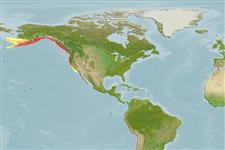Classification / Names
Common names from other countries
Main reference
Size / Weight / Age
Max length : 152 cm TL male/unsexed; (Ref. 2850); max. published weight: 59.1 kg (Ref. 40637); max. reported age: 25 years (Ref. 55701)
Length at first maturity
Lm ?, range 61 - 76 cm
Environment
Marine; demersal; oceano-estuarine (Ref. 51243); depth range 0 - 475 m (Ref. 6793)
Climate / Range
Temperate, preferred 10°C (Ref. 107945); 61°N - 31°N, 172°W - 116°W
Distribution
Northeast Pacific: Shumagin Islands in the western Gulf of Alaska to Ensenada, Baja California, Mexico. Possibly occurring in the Bering Sea (Ref. 6793).
Countries | FAO areas | Ecosystems | Occurrences | Introductions
Short description
Dorsal
spines
(total): 24 - 27;
Dorsal
soft rays
(total): 21-24;
Anal
spines: 3;
Anal
soft rays: 21 - 24;
Vertebrae: 55 - 59. Anal spines of adults buried in flesh, third spine closely applied to first ray (Ref. 6885). Head without scales; fleshy cirrus above each eye; large mouth; maxilla reaching almost to vertical from posterior margin of eye. Jaws with small pointed teeth interspersed with large fanglike teeth (Ref. 48751).
IUCN Red List Status (Ref. 115185)
Threat to humans
Traumatogenic (Ref. 13513)
Human uses
Fisheries: commercial; gamefish: yes
Tools
Special reports
Download XML
Internet sources
Estimates of some properties based on models
Phylogenetic diversity index
PD50 = 1.0002 many relatives (e.g. carps) 0.5 - 2.0 few relatives (e.g. lungfishes)
Trophic Level
4.5 ±0.6 se; Based on diet studies.
Resilience
Low, minimum population doubling time 4.5 - 14 years (tm=4; tmax=25;)
Vulnerability
High vulnerability (63 of 100)
Price category
